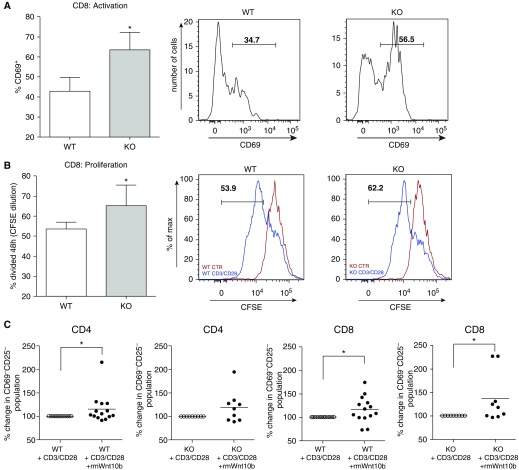Figure 5.
T cell receptor activation in Wnt10b−/− T cells leads to a diminished population of naive, CD69−CD25− cells, which can be reversed by addition of recombinant Wnt10b. (A) Wnt10b−/−, CD8+ primary splenic T cells exhibit an increased population of activated, CD69+ cells after 72-hour incubation with CD3/CD28 activator beads (n = 3/group, *P < 0.05, t test, data representative of two independent experiments, data are presented as mean ± SD; representative histograms for CD69+ cells isolated from WT and Wnt10b−/− mice). (B) Wnt10b−/− CD8+ T cells show increased proliferation 48 hours after in vitro CD3/CD28 activation, measured by carboxyfluorescein diacetate succinimidyl ester (CFSE) dilution. This effect did not reach significance in CD4+ cells (n = 6/group; *P < 0.05, t test, compiled data from two independent experiments, data are presented as mean ± SD; representative histograms with unactivated cells [red] and CD3/CD28 beads incubated cells [blue] for WT and Wnt10b−/−, respectively). (C) Addition of one or two doses of recombinant Wnt10b (200 ng/ml) increases the proportion of naive CD4+ and CD8+ cells in the total population, not only in Wnt10b−/− mice, but also in WT controls (n = 9–14/group; depicted as percent change of activated to activated and treated animal; *P < 0.05, Wilcoxon paired-rank test, compiled data from four independent experiments, data are presented as individual values with mean).

